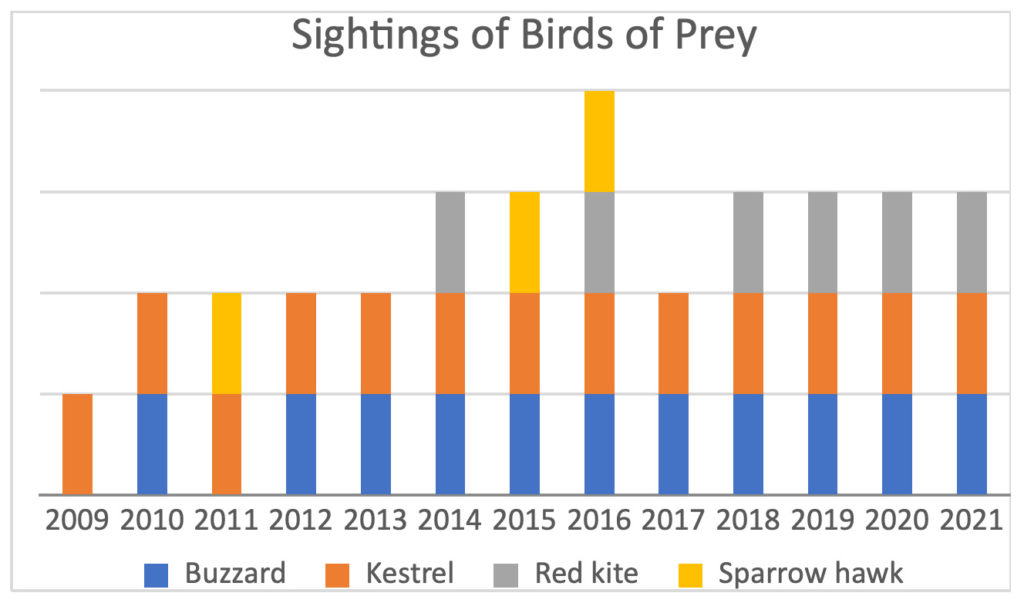Stapleford Bird Club - summary of records 2009-2021
The species recorded during monthly walks around a set transit at Magog Down have been entered into a spreadsheet. If a species has been recorded on any one of the 13 annual visits the spreadsheet shows a 1 in that year. A separate column headed ‘No. of years sighted’ shows the total number of years the species was recorded. The total number of species recorded each year is relatively constant, with an average of 44 (range from 35 to 53).
The bird families have been classed into 4 Groups: Residents, Summer Migrants, Winter Migrants and Fly Overs. Most of the Residents and Summer Migrants are probably breeding on the Down.
Birds of Prey
Only the Kestrel is a regular Resident recorded in all 13 years. The Buzzard has been recorded in 11 years but there is no current evidence that it is breeding on the Down. The Sparrow Hawk flies over very occasionally but is unlikely to be breeding on the Down. In line with the remarkable spread of Red Kites in England they are now frequently recorded flying over but not breeding on the Down.

Buntings
The Corn Bunting has been recorded in 12 years but only in small numbers. It probably breeds on the Down or nearby. The Yellowhammer is a breeding Resident recorded in 12 years but again always in small numbers. The Reed Bunting has been recorded in 6 years but only in very small numbers; it is not classified as a Resident because it leaves in early summer to breed in wetlands.
Crows
Most of the Crow family are regularly recorded on the Down usually eating ‘grubs’ in the Sheep Pastures. Some Carrion Crows probably breed on Magog Down but the Rooks, Jackdaws and Starlings do not. Individual Jays are seen every year near or in the woods and probably breed there.
Finches
Chaffinches, Goldfinches, Greenfinches and Linnets are all regularly recorded breeders. Bullfinches are much less common (9 years) but because of their small numbers, quiet song and secretive habit are probably regular Residents.
Larks and Pipits
The Down supports many breeding Skylarks which are recorded every year. The Meadow Pipit is often recorded on North Down (9 years) but it is not clear if it stays long enough to breed.
Partridges and Pheasants
Both Grey and Red Legged Partridge are Residents in small numbers on the Down but not always seen because of their secretive habits. Individual Pheasants are recorded most years probably sheltering from local Shoots.
Pigeons and Doves
Wood Pigeons are by far the commonest species on the Down where they breed in all the woods. The Collared Dove is rarely recorded (3) but the Stock Dove has been seen in four of the last five years.
Tits
This family is very well represented on the Down with Blue, Great and Long Tailed Tits breeding every year. The Coal Tit (4 years) is much less common probably in part because of the shortage of evergreen trees.
Thrushes
Blackbirds and Song Thrushes are breeding Residents recorded every year. Mistle Thrushes (11 years) are reliable breeding Residents but only in small numbers. The Winter Migrants Fieldfare and Redwing arrive each year, normally in November, to ‘cheer up’ the long winter months.
Warblers
These breeding Summer Migrants are well represented on the Down. Blackcaps, Chiffchaffs and the Common Whitethroat arrive in substantial numbers every year. The Lesser Whitethroat (5 years) is becoming a more frequent visitor to the Down but the Willow Warbler has not been heard on the Down for 8 years having once been a regular visitor. The Garden Warbler is an ‘unreliable’ visitor (4 years). The Sedge Warbler was only heard in two years when it inhabited crops of Oilseed Rape for a few weeks, before presumably leaving to breed in a normal habitat.

Woodpeckers
The Green Woodpecker is a regular breeding Resident that has been recorded every year, but the Greater Spotted Woodpecker was only recorded in 4 of the 13 years; this is probably because its home range includes the Wandlebury woodlands.
Owls
Although there is extensive grassland on the Down no Barn Owls have ever been recorded. The Tawny Owl has only been recorded in one year. ‘One off’ night-time surveys did not record any owls.
Other Species
Dunnocks and Wrens are recorded in substantial numbers during all surveys on the Down and breed every year. The Goldcrest is not an easy species to hear or see but has been recorded in 10 years which suggests it is a regular breeding Resident. However, there has been a fall-off in sightings of Swallows and House Martins over time.
It is hoped that regular monthly meetings of Stapleford Bird Club on the first Saturday of each month will resume shortly (they stopped in March 2020 because of the Covid-19 pandemic) and are currently on hold until a new leader is in post. Scroll down this page for more details.
Bryan Davies, January 2022
